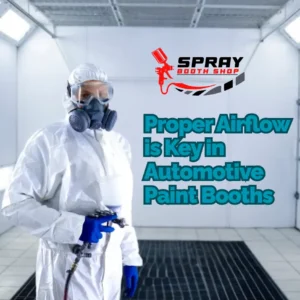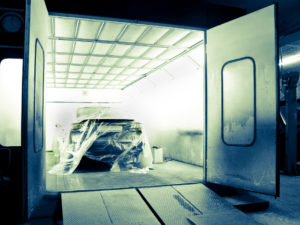
Optimizing Airflow in Automotive Spray Booths for Cleaner Finishes and Faster Cycle Times
In automotive refinishing, flawless results don’t start with the spray gun—they start with air. The way clean, conditioned air moves through a spray booth governs everything: finish clarity, cycle time, technician safety, and compliance. When airflow is precise and consistent, overspray is swept away, contaminants stay out, and curing stays on schedule. When it isn’t, defects like dust nibs, fisheyes, and dull, hazy panels—and the rework that follows—become inevitable. With the U.S. refinish coatings market at $3.1 billion and growing, the cost of poor airflow is too high to ignore.
This article explains airflow: laminar flow’s gold standard, design differences, and positive pressure with filtration protecting finishes and teams. You’ll learn how fan sizing, AMUs, ducting, and diffusion media integrate, risks of turbulence and clogs, and gauge-based monitoring. We’ll also cover practical air-balancing techniques and smart controls that shorten cycles and cut energy use. Master the air, and you’ll master the finish—consistently, safely, and profitably.
The Quest for a Flawless Finish: More Than Just Paint
Achieving a showroom-quality finish involves controlling a complex set of variables. While the painter’s technique and the chemical composition of the paint are crucial, they are rendered ineffective in an uncontrolled environment. A paint booth is designed to be a sealed chamber where these variables can be managed, and airflow is the primary tool for that management. It serves as a dynamic conveyor belt, carrying away harmful overspray while simultaneously protecting the wet surface from contamination.
Why Airflow is Non-Negotiable: Preventing Common Defects
Without meticulously engineered airflow, common paint defects become inevitable. Issues like dust nibs, fisheyes, solvent popping, and inconsistent gloss are often direct symptoms of a compromised ventilation system. Poor ventilation allows airborne debris to settle on fresh paint, while uncontrolled overspray can create a hazy, dull finish. Proper airflow is the proactive defense against these quality-killers, ensuring a clean, contaminant-free environment from the moment the spray gun is triggered.
A Blueprint for Success: Understanding, Optimizing, and Maintaining Airflow
Mastering airflow requires a comprehensive approach. It begins with understanding the fundamental science of air movement and the different types of spray booth systems. It also includes systematically optimizing key components—fans and filters—and, most importantly, consistently committing to a rigorous maintenance schedule. Treat the ventilation system as a precision instrument, not an exhaust fan, unlocking performance, efficiency, and unparalleled finish quality.
The Fundamental Science: How Airflow Shapes Perfection
At its core, the function of a paint booth’s ventilation system is to create a predictable and controlled atmosphere. This isn’t just about moving air; it’s about shaping its path, velocity, and purity to serve the specific needs of the automotive painting process. Understanding the physics behind this movement is the first step toward appreciating its profound impact on the final product.
Beyond Basic Ventilation: Understanding Air Movement Patterns
Effective ventilation is defined by its pattern. Air must be introduced and exhausted in a way that systematically sweeps overspray and contaminants away from the vehicle. The goal is to create a consistent, non-disruptive current that envelops the workpiece. This controlled movement prevents Overspray from swirling back and settling on the vehicle or other booth surfaces, ensuring that only fresh, atomized paint reaches its target.
Laminar Flow: The Gold Standard for Contaminant Control
The ideal air movement pattern in a high-performance paint booth is laminar flow. This refers to air moving in smooth, parallel layers with minimal crossover or turbulence. In a downdraft booth, for example, laminar flow creates a vertical curtain of clean air that flows from the ceiling, over the vehicle, and into the floor exhaust pits. This pattern is exceptionally effective at capturing overspray and dust particles, pulling them directly downward and away from the freshly painted surfaces, ensuring maximum purity during the critical application phase.
The Detrimental Effects of Turbulent Airflow
Turbulence is the enemy of a perfect finish. When airflow is disrupted—by clogged filters, poorly designed ductwork, or incorrect fan speeds—it creates eddies and chaotic currents within the booth. This turbulent air can pick up dust and debris from the floor or corners and deposit it directly onto the wet paint. It also fails to effectively capture overspray, allowing it to hang in the air, creating a hazy environment that compromises both visibility and the final finish quality.
Types of Airflow Systems and Advantages
Automotive paint booths have different airflow configurations, each offering a unique balance of performance, space requirements, and cost. The choice of system directly influences the level of contaminant control and the overall quality achievable. Understanding these designs is key to selecting and optimizing the right environment for specific painting applications.
Downdraft Booths: The Optimal Choice for Precision and Quality
Considered the pinnacle of spray booth technology, downdraft booths provide the cleanest possible painting environment. Air is introduced through filtered diffusers in the ceiling and pulled downwards, exiting through a grated floor or pits. This top-to-bottom laminar flow is the most effective method for controlling overspray and contamination, as gravity assists in pulling particles away from the vehicle. This design minimizes the risk of dust and debris settling on horizontal surfaces, making it the preferred choice for high-end automotive and collision repair shops demanding flawless finishes.
Crossdraft Booths: Practicality and Performance for Diverse Applications
In a crossdraft booth, air enters through filtered doors or a front wall and flows horizontally across the length of the vehicle, exiting through an exhaust chamber at the rear. This design is often more space-efficient and cost-effective to install as it doesn’t require the extensive concrete work of a downdraft pit. While highly effective, the horizontal airflow pattern can sometimes allow overspray to be pulled across the side of the vehicle, requiring meticulous technique from the painter to manage.
Semi-Downdraft Booths: A Balanced Approach to Efficiency
Semi-downdraft booths offer a hybrid solution. Clean air enters at the front ceiling and flows diagonally over the vehicle toward the booth’s rear exhaust plenum. This design improves on traditional crossdraft layouts by creating a more downward-angled stream, directing overspray away from the workpiece. It offers markedly better contamination control than crossdraft booths, without the full cost or construction complexity of downdraft systems.
Maintaining Pressure Balance: The Critical Role of Positive Pressure
Regardless of the airflow design, maintaining a slight positive pressure inside the booth is critical. This is fit when the ventilation system brings in slightly more air than the exhaust fans remove. This positive pressure ensures that any potential leaks in the booth structure will push clean air out, rather than allowing unfilter, dust-laden air from the surrounding shop. It’s a simple yet powerful principle that acts as an invisible shield against external contamination.
The Filtration Ecosystem: Guardians of Air Quality and Finish Integrity
The most sophisticated airflow design is useless without an effective filtration system. Filters are the unsung heroes of the paint booth, working tirelessly to purify the air at both the intake and exhaust stages. This filtration ecosystem is the primary defense against the microscopic contaminants that can ruin an otherwise perfect paint job.
Intake Filtration: The First Line of Defense Against Imperfections
Intake filters are responsible for cleaning the air before it ever enters the paint booth. Typically arranged in multiple stages, they remove dust, pollen, and other airborne debris from the shop environment. The final stage, often a ceiling-mounted diffusion media, ensures the air entering the painting chamber is exceptionally clean. Intake filtration quality directly correlates with the likelihood of dust nibs and other surface imperfections in the final finish.
Exhaust Filtration: Capturing Contaminants Safely and Responsibly
Exhaust filters serve a dual purpose: protecting the environment and the booth’s mechanical components. These filters capture paint overspray before exhaust air exits, preventing atmospheric pollution and maintaining compliance with environmental regulations. They also protect exhaust fans and ductwork from sticky, flammable paint residue buildup, essential for performance and fire safety.
The Critical Impact of Filter Maintenance: From Clogged Filters to Flawless Finishes
Neglecting filter maintenance is one of the fastest ways to compromise a paint booth’s performance. Clogged filters dramatically increase resistance, forcing fans to work harder while delivering less air. This reduction in airflow velocity cripples the system’s ability to remove overspray, leading to a hazy booth and poor finish quality. Furthermore, choked intake filters can cause the booth to lose its positive pressure, turning it into a vacuum that actively pulls in dust and debris from the outside. Regular monitoring and replacement are not just maintenance tasks; they are critical process controls.
Engineering the Flow: Key Components for Optimal Airflow Management
The consistent, clean airflow required for a perfect finish is the result of several key mechanical components working in harmony. The fans, air makeup unit, and ductwork form the core of the ventilation system, and the performance of each element is critical to the overall efficiency and effectiveness of the paint booth.
The Powerhouse: Paint Booth Fans and Blowers
Fans are the heart of the ventilation system, responsible for moving the massive volumes of air required for proper ventilation. These are typically high-capacity tube-axial or vane-axial fans designed for industrial use. The size and power of these fans must be precisely matched to the booth’s dimensions and filter specifications to achieve the target airflow velocity. In modern systems, Variable Frequency Drives (VFDs) are often used to control fan speed, allowing for energy savings during non-spraying cycles and precise control over booth pressure.
Air Makeup Units (AMUs): Controlling the Environment
An Air Makeup Unit is a sophisticated piece of equipment that conditions the air before it enters the booth. The AMU heats incoming air to optimal temperatures for paint application and curing, ensuring proper adhesion and flash-off timing. It also houses primary intake filters, keeping booth supply air clean and correctly tempered for consistent environmental control.
Ductwork and Diffusion: Guiding the Air with Precision
While fans provide the power, the ductwork and diffusion media provide the direction. Properly designed ductwork ensures smooth, efficient air transport from the AMU and to the exhaust stack with minimal turbulence and pressure loss. Inside the booth, ceiling diffusion media evenly distribute the clean, conditioned air, which is essential for creating the consistent, laminar flow needed to sweep away overspray and contaminants without creating drafts or dead spots.
The Cost of Compromise: Consequences of Improper Airflow
When airflow is compromised, the consequences extend far beyond a few surface imperfections. Poor ventilation creates a domino effect of quality issues, operational bottlenecks, financial strain, and significant safety hazards. In a growing automotive refinish market expected to reach $13.11 billion in 2025, the cost of these preventable mistakes is substantial.
Detrimental Effects on Finish Quality: Directly Causing Paint-Related Defects
Inadequate airflow is a primary cause of paint-related defects. Insufficient air movement fails to capture overspray, leading to a gritty, hazy texture on the final surface. This allows airborne dust and debris to settle on wet paint, creating nibs and imperfections that demand time-consuming sanding. In severe cases, entire panels may need to be repainted, doubling material costs and labor time.
Operational Inefficiencies and Financial Strain
Poor airflow is a direct drain on a shop’s bottom line. Rework caused by paint defects consumes valuable technician time, materials, and booth cycles, reducing overall throughput. Furthermore, a system with clogged filters forces fans to work harder, dramatically increasing energy consumption. Considering that equipment like fans and compressors can account for 40% of an auto body shop’s electricity use, the financial penalty for neglected airflow maintenance is significant and ongoing.
Safety Hazards and Regulatory Non-Compliance
A properly functioning ventilation system is essential for technician safety. Maintain solvent vapor concentrations well below flammable and hazardous exposure limits. Inadequate airflow allows these vapors to accumulate, creating a serious fire risk and an unhealthy breathing environment. This directly contravenes safety regulations from bodies like OSHA and the NFPA, exposing the business to heavy fines and legal liability in addition to endangering personnel.
Proactive Airflow Management: Ensuring Optimal Performance
Achieving and maintaining optimal airflow is not a “set it and forget it” task. It requires a proactive, data-driven approach to management and maintenance. By regularly monitoring key performance indicators and understanding how to balance the system, shops can ensure their paint booth operates at peak efficiency, quality, and safety day after day.
Monitoring Airflow: Tools and Techniques for Data-Driven Decisions
Effective management starts with measurement. A manometer or differential pressure gauge is an essential tool for monitoring the condition of filters by measuring the pressure difference across them. As filters accumulate contaminants, pressure drop rises, giving a clear numerical indicator for timely, necessary replacement scheduling and maintenance. Additionally, use an anemometer periodically to measure booth air velocity, ensuring it meets design specifications for effective overspray control.
Achieving Air Balancing: The Art of Precise Control
Air balancing is the process of fine-tuning the intake and exhaust systems to achieve the desired airflow velocity and booth pressure. This involves adjusting fan speeds, dampers, and other controls to ensure the system is moving the correct volume of air while maintaining a slight positive pressure. This delicate balance is the key to preventing contamination, optimizing overspray removal, and ensuring the booth performs exactly.
The Future of Airflow: Smart Systems and Sustainability
The industry is moving towards more intelligent paint booth systems. Modern booths increasingly feature integrated sensors and automated controls that monitor airflow, pressure, and filter status in real-time. These “smart” systems can automatically adjust fan speeds via VFDs to maintain perfect balance and optimal energy efficiency. As the automotive paint spray booths market is projected to grow to $1.9 billion by 2032, these innovations in efficiency and performance will become the new standard.
The Air Master the Finish
Proper airflow is the invisible lifeblood of a high-performance automotive paint booth. It is a dynamic force that directly governs finish quality, operational efficiency, technician safety, and regulatory compliance. From the fundamental principles of laminar flow to the precise engineering of fans and filtration systems, every aspect of the ventilation system creates a perfectly controlled environment where flawless finishes are not just possible, but repeatable.
Compromising on airflow is a direct compromise on the quality of your work and the profitability of your business. The path to excellence lies in proactive management: embracing a data-driven maintenance philosophy of “gauges, not guesses,” regularly monitoring system performance, and understanding the critical interplay between components. By treating the airflow system as the precision instrument it is, automotive refinishing professionals can ensure every vehicle that leaves their booth is a testament to their commitment to perfection.

 Direction of Airflow in Paint Booths
Direction of Airflow in Paint Booths